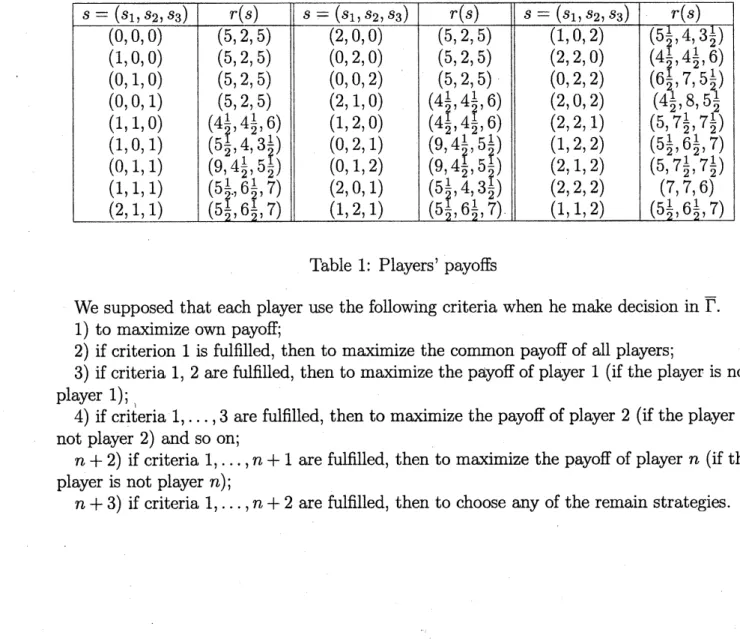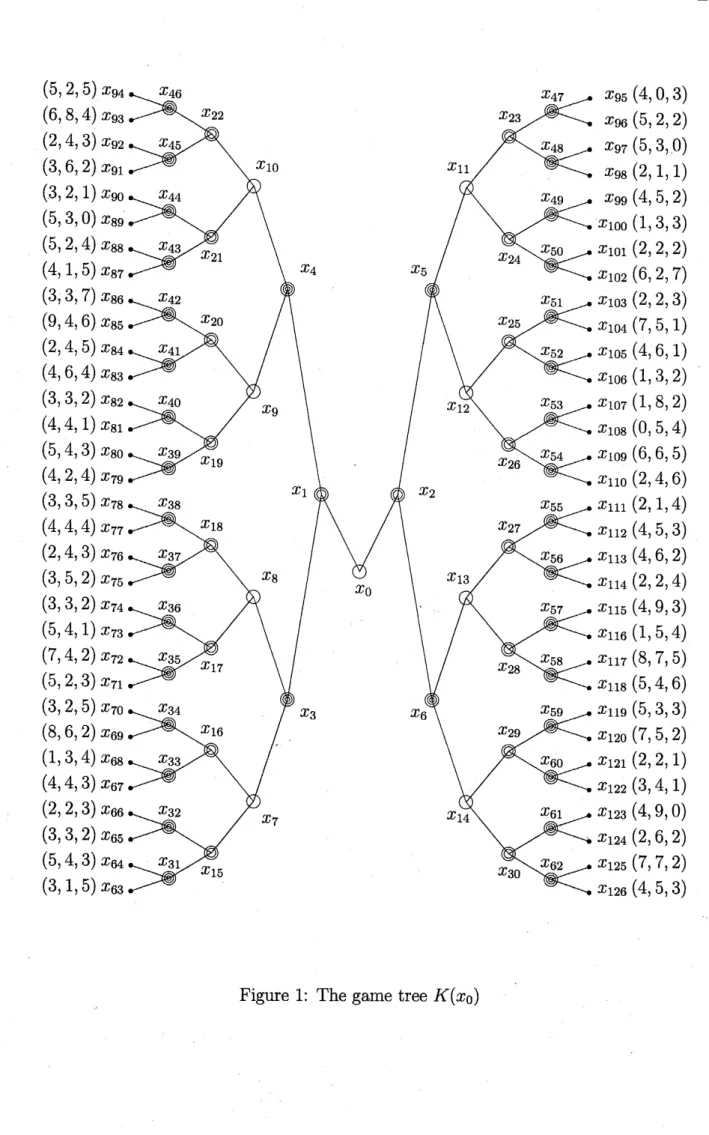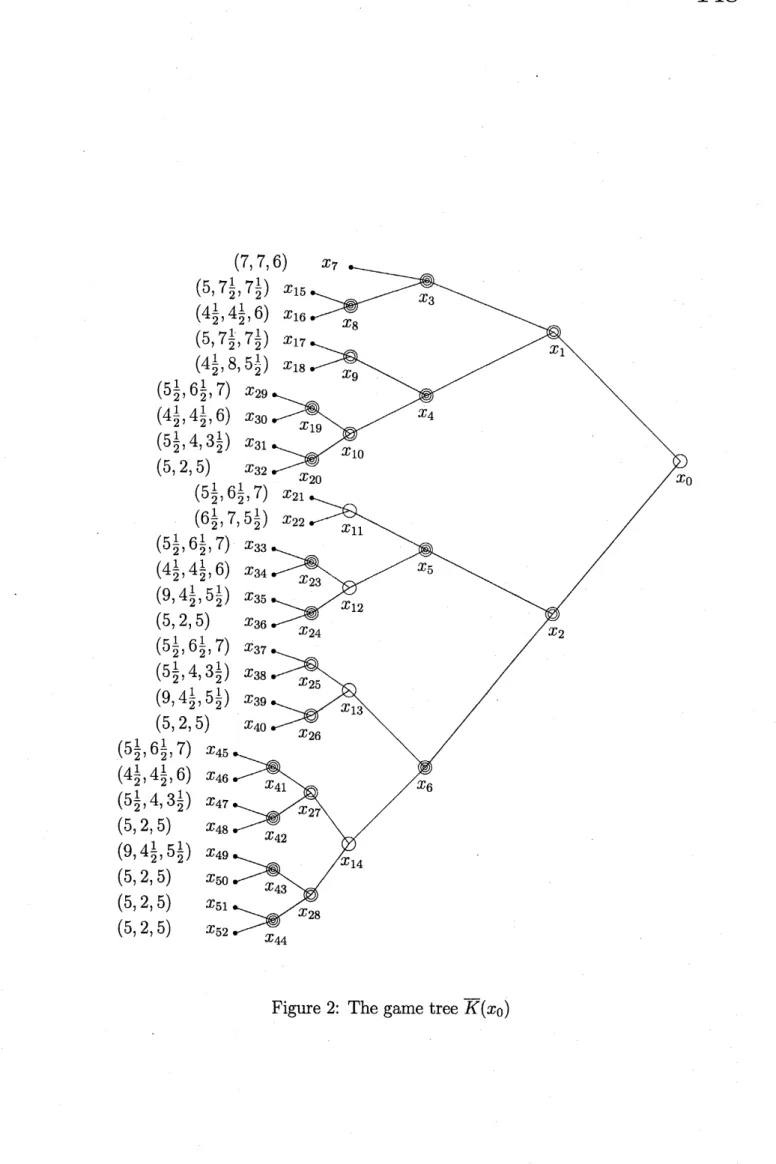On the Nash
equilibrium of partial
cooperative
games
Department of Information Science,
Hirosaki University
Dmitri A.
Ayoshinl
Department ofMathematical System Science,
Hirosaki University
Tamaki
Tanaka2
Department of Applied Mathematics,
St. Peterburg State University
Leon
A.
Petrosjan3
1
Introduction
In [4] a class of partial cooperative games with perfect information (PCGPI) is defined.
PCGPI proceeds on a tree $K(x_{0})$ of a finite non-cooperative game in extensive form with
perfect information and without chance moves $\Gamma=\langle K(x_{0}), P, h\rangle$
.
Here, $x_{0}$ is the originof $K(x_{0});\mathrm{P}$ denotes the player partition $P_{1},$
$\ldots$ ,$P_{i},$ $\ldots,$$P_{n},$ $P_{n+1}$, where $P_{i},$ $i\in N$, is the
set of decision points of player $i$, and $P_{n+1}$ is the set of the endpoints; $h$ : $P_{n+1}arrow R_{+}^{n}$
is the terminal payoff function. Denote the player set by $N=\{1, \ldots , n\}$. In PCGPI for
each player $i$ a set of points called the cooperative region is given. (In general case the
cooperative region may be empty.) During the game, in a decision point $x\in P_{i}$ player $i$ is
purposed to use an individually rational behavior if $x$ is not in his cooperative region. But,
if $x$ lies in the cooperative region of player $i$, then in $x$ he forms a coalition involving all
$\dot{\mathrm{p}}\mathrm{l}\mathrm{a}\mathrm{y}\mathrm{e}\mathrm{r}\mathrm{s}$whose cooperative regions eontain
$x$ also.
Formalizationof the concept of theplayers’ cooperative regionmay be realized by various
approaches. In [4] a timing interpretation of the cooperative region is considered. It is
supposed that $K(x_{0})$ has the following information structure:
1. For any evolution of the game players make decisions in accordance with their index
order, i.e., inthe point$x_{0}$ thedecisionis madebyplayer 1, in theimmediatesuccessors
of $x_{0}$ the decision is made by player 2 and so on until player $n$
.
After player $n$ thedecision is again made by player 1 and etc.
2. Each path has the same lengh.
For the given game tree, we shall say that a stage is the $n$sequential $\mathrm{m}\mathrm{o}.\mathrm{v}$es, where thefirst
move is made by player 1. Let the length of$K(x_{0})$ be $T+1$ stages.
1 -mail: srdima@si.hirosaki-u.ac.jp 2 -mail: tanaka@cc.hirosaki-u.ac.jp
In PCGPI a vector $s=(s_{1}, \ldots, s_{i}, \ldots, s_{n}),$ $s_{i}\in\overline{L}=\{0,1, \ldots , T, T+1\}$, is given. The
component $s_{i}$ denotesthe length of the player
$i’ \mathrm{s}$ cooperative activity. If$s_{i}=0$, thenduring
the game player $i$ plays non-cooperatively. If $s_{i}>0$, then starting form the initial stage $0$
until the stage $T-s_{i}$ player $i$ plays non-cooperatively, and since the stage $t_{i}=T-s_{i}+1$
until the end of the game player $i$ is ready to cooperate with anybody. The given PCGPI is
denoted by $\Gamma_{s}(x_{0})$.
Suppose that $\{x_{0}, \ldots,\overline{x}\}$ is the path realized in $\Gamma_{s}(x_{0})$
.
Let $S_{s}=\{i\in N|s_{i}>0\}$ be acoalition formed to the end of $\Gamma_{s}(x_{0})$. If$i\not\in S$, then the payoff of player $i$ is defined by the
terminal payofffunction $h$ and equals $h_{i}(\overline{x})$. If$i\in S_{s}$, then the payoffof player $i$ is defined
by the Shapleyvalue $\alpha(s)$ of the payoffof the coalition $S_{s}$, i.e.,
$\sum_{j\in S_{s}}\alpha_{j}(s)=\sum_{j\in S_{s}}h_{j}(\overline{x})$
It is considered that the purpose ofa player in $\Gamma_{s}(x_{0})$ is maximizing his payoff within the
restrictions given by $s$.
Let $L=\Pi_{i\in N}\overline{L}$ be the set of all vectors $s$ that can be defined for $K(x_{0})$
.
In [4] anapproach to find the players’ optimal behavior in $\Gamma_{s}(x_{0}),$ $s\in L$, is proposed. The scheme
of construction of a path $\Phi_{s}(x_{0})=\{x_{0}, \ldots , \phi_{s}(x_{0})\},$ $\phi_{s}(x_{0})\in P_{n+1}$, which is realized in
$\Gamma_{s}(x_{0})$ when players keep on their optimal behavior, is defined. The payoff-vector $r(s)=$
$(r_{1}(s), \ldots, r_{n}(s))$, $\mathrm{s}$ $r_{i}(s)=\{$ $h_{i}(\phi_{\mathit{8}}(x_{0}))$, if$s_{i}=0$ $\alpha_{i}(s)$, if$s_{i}>0$, $i\in N$
related to $\Phi_{s}(x_{0})$ is called the value of $\Gamma_{s}(x_{0})$.
In $\Gamma_{s}(x_{0})$ the vector $s$ is not regulated by players. In this paper we consider a
generaliza-tion of$\Gamma_{s}(x_{0})$, where players form a vector $s\in L$ themselves.
2
Model.
On the tree $K(x_{0})$ consider a new game $\Gamma_{L}(x_{0})$. In pre-play communications of $\Gamma_{L}(x_{0})$
players form a vector $s\in L$
.
Then, players play in accordance with the vector $s$.
Hence,$\Gamma_{L}(x_{0})$ evolves along the optimal path $\Phi_{s}(x_{0})$ and players get payoffs defined by the value
$r(s)$
.
It is supposed that in $\Gamma_{L}(x_{0})$ each player tries to maximize his own payoff.Definition. A vector $s^{*}\in L$ is called the Nash equilibrium of$\Gamma_{L}(x_{0})$ iffor all $s_{i}\in\overline{L}$ and
$i\in N$ there is
$r_{i}(s^{*})\geq r_{i}(s^{*}|s_{i})$, (2.1)
where $s^{*}|s_{i}=$ $(s_{1}^{*}, \ldots, s_{i-1}^{*}, s_{i}, s_{i+1}^{*}, \ldots , s_{n}^{*})$.
Theorem. The Nash equilibrium in $\Gamma_{L}(x_{0})$ always exists.
Proof.
We prove the theorem if propose the Nash equilibrium construction method for$\Gamma_{L}(x_{0})$.
Knowingthe formed vector$s$ weknow thepath$\Phi_{s}(x_{0})$ of the game evolution and players’
payoffs $r(s)$. Therefore, the set $\overline{L}$ may be considered as the set of the player’s strategies in
$\Gamma_{L}(x_{0})$
.
For each player $i$ and his decision point $x\in P_{i}$, if player $i$ cooperates in $x$ or notBasing
on
$K(x_{0})$, definean
auxiliary binary tree $\overline{K}(x_{0})$. The length of $\overline{K}(x_{0})$ is $T+1$stages (the definition of a stage is given in section 1). For each decision point $x$, we shall
call the branches going out from $x$ by
Left
and Right respectively. We shall consider that ifplayer $i$ does not cooperatein astage$t$, thenon$\overline{K}(x_{0})$ player $i$ has to go Left inhis decision
points in the stage $t$. Otherwise, ifplayer $i$ cooperates in the stage $t$, then on $\overline{K}(x_{0})$ player
$i$ has to go Right in his decision points in the stage
$t$. For the given relation between the
rules of$\Gamma_{L}(x_{0})$ and $\overline{K}(x_{0})$ to be $\mathrm{o}\mathrm{n}\mathrm{e}-\mathrm{t}\mathrm{o}-\mathrm{o}\mathrm{n}\mathrm{e}$, we suppose that
$\overline{K}(x_{0})$
satisfies.
the followingcondition.
Let $x_{r}$ and $x_{l}$ be immediate
successors
of a decision point $x$.
Assume that $x_{r}$ related tothe decision Right in $x$, and $x_{\ell}$ related to the decision Left in $x$. Then,
$K(x_{r})\cap P_{i}=\emptyset$ (2.2)
for each player $i\in N$ and his decision point $x\in P_{i}$
.
Here, $K(x_{r})$ denotes the subtree withthe initial point $x_{r}$
.
Let$\overline{P}_{1,)}\ldots\overline{P}_{n},$ $\overline{P}_{n+1}$ betheplayer partition on$\overline{K}(x_{0}))\mathrm{w}\mathrm{h}\mathrm{e}\mathrm{r}\dot{\mathrm{e}}\overline{P}_{n+1}$
is the set of endpoints.
By the condition (2.2) there is $\mathrm{o}\mathrm{n}\mathrm{e}-\mathrm{t}\mathrm{o}$-one correspondence between the sets $L$
and $\overline{P}_{n+1}$
.
Define a payoff function $\overline{h}$: $\overline{P}_{n+1}arrow R_{+}^{n}$ by
$\overline{h}(\hat{x})=r(s)$, $\hat{x}\in\overline{P}_{n+1}$ (2.3)
where $\hat{x}$ related to
$s$. Consider a non-cooperative game $\overline{\Gamma}=\langle\overline{K}(x_{0}), \overline{P},\overline{h}\rangle$
.
Let $\pi=$$(\pi_{1}, \ldots, \pi_{n})$ denote a situation in $\overline{\Gamma}$
, where $\pi_{i},$ $i\in N$, is a player $i’ \mathrm{s}$ strategy. Denote the
set of all situations in $\overline{\Gamma}$
by II. Suppose that $\pi^{*}$ is the Nash equilibrium in $\overline{\Gamma}$
.
From the
construction of the game $\overline{\Gamma}$
it follows that there is $\mathrm{o}\mathrm{n}\mathrm{e}-\mathrm{t}\mathrm{o}$-one correspondence between $\Pi$
$\Gamma_{L}(x_{0})\mathrm{a}\mathrm{n}\mathrm{d}L.$
.
Hence, the vector $s^{*}$ related to $\pi^{*}$ satisfies the definition of the Nash equilibrium
$\mathrm{i}\mathrm{n}\square$
Remark. During the theorem proof a construction method of the Nash equilibrium in
$\Gamma_{L}(x_{0})$ was proposed.
Example. Consider a three person non-cooperative game $\Gamma$ with the game tree $K(x_{0})$
given in Figure 1. $N=\{1,2,3\}$
.
Theplayer l’s decision points aredenoted by single circle,player $2’ \mathrm{s}-\mathrm{b}\mathrm{y}$ double circle andplayer $3’ \mathrm{s}-\mathrm{b}\mathrm{y}$ triple circle. Thevectors at theendpoints
are the terminal payoffs of players, with the first components being the payoff of player 1
and so on. There are two stages in $\Gamma$
.
The initial stage starts in$x_{0}$
.
The stage 1 starts in $x_{7},$ $x_{8},$ $x_{9},$ $x_{10},$ $x_{11},$ $x_{12},$ $x_{13},$ $x_{14}$.
$\overline{L}=\{0,1,2\}$. For each $s\in L$ consider the game $\Gamma_{s}(x_{0})$and find the value $r(s)$
.
All possible values $r(s),$ $s\in L$,are
given in Table 1.Find the Nash equilibrium $s^{*}$ of the game $\Gamma_{L}(x_{0})$
.
Construct the tree $\overline{K}(x_{0})$ (see inFigure 2) which satisfies the condition (2.2).
We shall say that player 1 goes Up in $x_{0}\in\overline{K}(x_{0})$, if he cooperates in $\Gamma_{L}(x_{0})$ since the
initial stage. Player 1 goes Down in $x_{0}\in\overline{K}_{(}x_{0}$), if he does not cooperate in $\Gamma_{L}(x_{0})$ in the
initial stage. In $x_{11},$ $x_{12},x_{13}$ and $x_{14}$ of$\overline{K}(x_{0})$ player 1 goes Up, ifhe cooperates in $\Gamma_{L}(x_{0})$
since the stage 1. If player 1 does not cooperate $\Gamma_{L}(x_{0})$, then he goes Down in
$x_{11},$ $x_{12},x_{13}$
and $x_{14}\mathrm{o}\mathrm{f}\overline{K}(x_{0})$
.
Player 2 goes Up in $x_{1},$ $x_{2}$ of$\overline{K}(x_{0})$, if he cooperates in $\Gamma_{L}(x_{0})$ since the initial stage
$x_{1}$,
in $x_{1},$ $x_{2}$ of$\overline{K}(x_{0})$. Player 2 goes Up in $x_{9},$ $x_{10},$ $x_{25},$ $x_{26},$ $x_{27},$ $x_{28}$ of$\overline{K}(x_{0})$, if he cooperates
in $\Gamma_{L}(x_{0})$ since the stage 1. If player 2 does not cooperate in $\Gamma_{L}(x_{0})$, then he goes Down in $x_{9},$ $x_{10},$ $x_{25},$ $x_{26},$ $x_{27},$ $x_{28}$ of$\overline{K}(x_{0})$
.
Player 3 goes Up in $x_{3},$ $x_{4},$ $x_{5},$ $x_{6}$ of$\overline{K}(x_{0})$, if he cooperates in $\Gamma_{L}(x_{0})$ since the initial
stage. Ifplayer 3 does not cooperate in $\Gamma_{L}(x_{0})$ in theinitial stage, then he goes Down in$x_{3}$,
$x_{4},$ $x_{5},$ $x_{6}$ of$\overline{K}(x_{0})$
.
Player 3 goes Up in $x_{8},$ $x_{19},$ $x_{20},$ $x_{23},$ $x_{24},$ $x_{41},$ $x_{42},$ $x_{43},$ $x_{44}$ of$\overline{K}(x_{0})$, ifhe cooperates in $\Gamma_{L}(x_{0})$ since the stage 1. Ifplayer 3 does not cooperate in $\Gamma_{L}(x_{0})$, then he
goes Down in $x_{8},$ $x_{19},$ $x_{20},$ $x_{23},$ $x_{24},$ $x_{41},$ $x_{42},$ $x_{43},$ $x_{44}\mathrm{o}\mathrm{f}\overline{K}(x_{0})$
.
Using the given interpretation of players’ behavior, we put the values $r(s),$ $s\in L$, at
the endpoints of $\overline{K}(x_{0})$
.
Define the non-cooperative game $\overline{\Gamma}$on $\overline{K}(x_{0})$ and find the Nash
equilibrium $\mathrm{o}\mathrm{f}\overline{\Gamma}$.
There are tree Nash equilibrium in $\overline{\Gamma}$. The
trajectories related to the Nash equilibrium
situations are $\{x_{0}, \ldots , x_{23}\},$ $\{x_{0}, \ldots, x_{35}\}$ and $\{x_{0}, \ldots, x_{45}\}$
.
Hence, the Nash equilibriumsin $\Gamma_{L}(x_{0})$ are $(0,2,1),$ $(0,1,2)$ and $(0,1,1)$. For all cases players get payoffs $(9, 4 \frac{1}{2},5\frac{1}{2})$. We
can seethat forplayer 1 it is optimal (in thesenseofthe Nashequilibrium) not tocooperate
in$\Gamma_{L}(x_{0})$. Note, that if all players cooperate sincethe start of$\Gamma_{L}(x_{0})$, thenwehave a usual
cooperative game on $K(x_{0})$
.
In this case, the Shapley value is (7, 7,6).$s=(s_{1}, s_{2}, s_{3})$ $r(s)$ $s=(s_{1}, s_{2}, s_{3})$ $r(s)$ $s=(s_{1}, s_{2}, s_{3})$ $r(s)$ $(0,0,0)$ $(1,0,0)$ $(0,1,0)$ $(0,0,1)$ $(1,1,0)$ $(1,0,1)$ $(0,1,1)$ $(1,1,1)$ $(2,1,1)$ $(5, 2, 5)$ $(5, 2, 5)$ $(5, 2, 5)$ $(5, 2, 5)$ $(9,4 \frac{1}{2},5\frac{\frac{1}{\not\in}}{2})(5\frac{\frac{1}{\not\in}}{2},4,3)(4,4\frac{1}{2},6)$ $(5,6,7)(5\underline{\frac{1}{\int}}.,6\underline{\frac{1}{21}},7)$ $(2, 0,0)$ $(0,2,0)$ $(0,0,2)$ $(2,1,0)$ $(1,2,0)$ $(0,2,1)$ $(0,1,2)$ $(2,0,1)$ $(1,2,1)$ $(5, 2, 5)$ $(5, 2, 5)$ $(5, 2, 5)$ $(4,4,6)(4 \frac{\frac{1}{\not\in}}{2},4\frac{\frac{1}{\not\in}}{2},6)$ $(9,4,5 \frac{1}{\not\in})(5\frac{1}{\underline\not\in},,,3)(9,4\frac{\frac{1}{\not\in}}{42},5\frac{}{\frac{\not\in}{2}})(5,6^{\underline{1}},7)$ $(1, 0,2)$ $(2,2,0)$ $(0,2,2)$ $(2,0,2)$ $(2,2,1)$ $(1,2,2)$ $(2,1,2)$ $(2,2,2)$ $(1,1,2)$ $(4 \frac{\overline\not\in}{\frac{\not\in}{2}},4\frac{1}{2},,6)(6,7,5\frac{1}{2})(5,4,3_{\overline{2}})$ $(4 \frac{1}{2},8,5\frac{1}{2}$ $(5,7 \frac{1}{2},7\frac{1}{2})$ $(5 \frac{1}{2},6\frac{1}{2},7)$ $(5,7 \frac{1}{2},7\frac{1}{2})$ $(7,7,6)$ $(5^{\underline{1}},6^{\underline{1}},7)$
Table 1: Players’ payoffs
We supposed that each player use the following criteria when he make decision in $\overline{\Gamma}$
.
1) to maximizeown payoff,
2) ifcriterion 1 is fulfilled, then to maximize the common payoff of all players;
3) ifcriteria 1, 2 arefulfilled, then to maximize the payoffof player 1 (if the player is not
player $1$);
4) ifcriteria 1,
.
. .
,3 are fulfilled, then to maximize the payoff of player 2 (ifthe player isnot player 2) and
so
on;$n+2)$ if criteria 1,
.
. .
,$n+1$ are fulfilled, then to maximize the payoffof player $n$ (iftheplayer is not player $n$);
References
[1] Hsiao C.R. and Raghavan T.E.S., The Shapley value
for
multi-choice games (I), Gamesand Economic Behavior 5 (1993), 240-256.
[2] Neumann J. vonand MorgensternO., Theory
of
gamesan.d
Economic Behavior,Prince-ton University Press, Princeton, New Jersey, (1944)
[3] Nash J.F., Non-cooperative games, Ann. of Math. 54 (1951), 286-295.
[4] Petrosjan L.A., Ayoshin D.A., Tanaka T., Construction
of
a Time Consistent Corein Multi-Choice Multistage Games, RIMS–97, Symposium “Decision Theory and Its
.Related
Fields” (1997).[5] Shapley L.S., A value
for
$n$-person games, Ann. of Math. 28 (1953), 307-317.[6] VorobjevN.N., GameTheoryLectures for Economists and SystemScientists,


